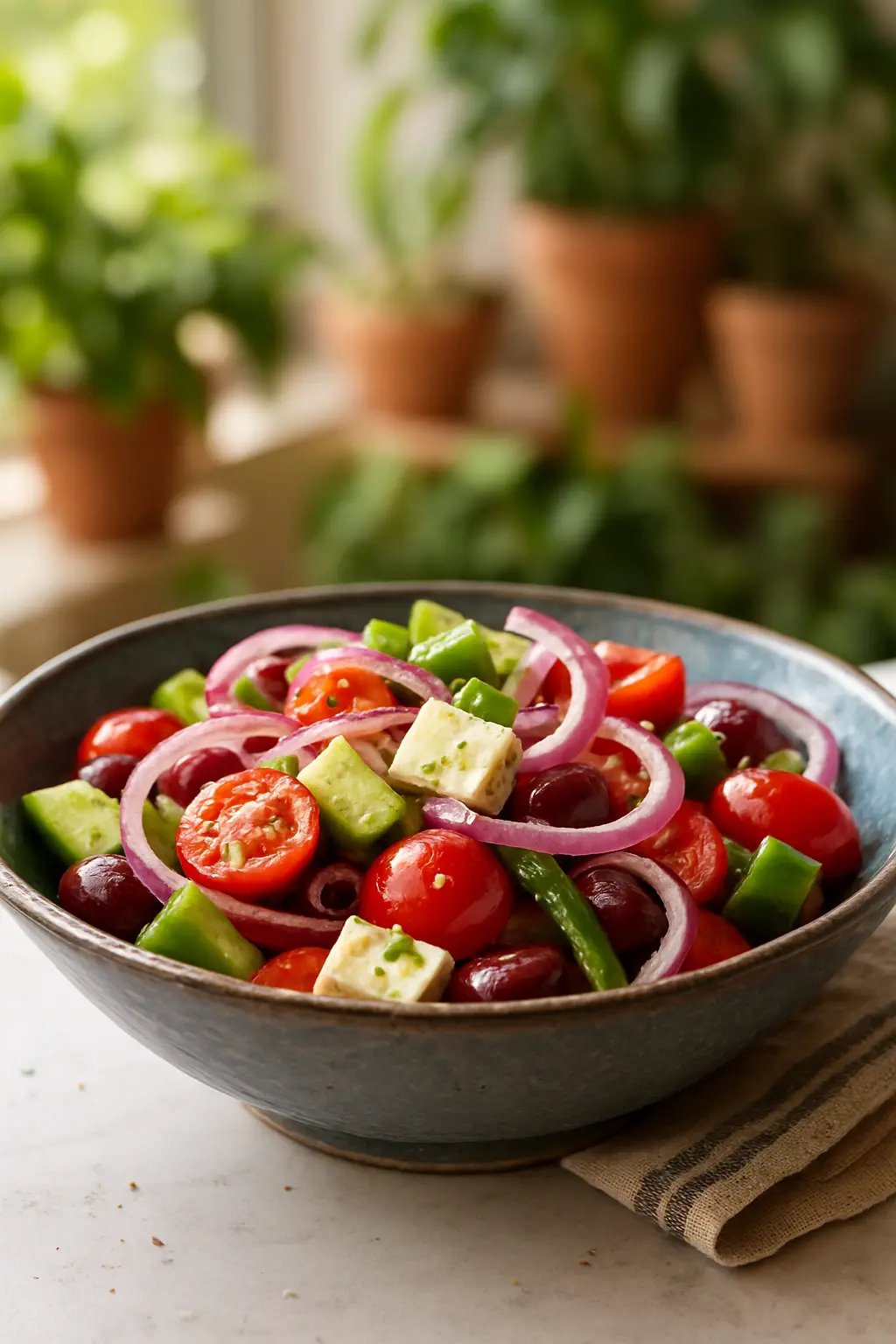Ultimate Greek Salad Recipe: A Fresh Mediterranean Classic
Experience the vibrant flavors of the Mediterranean with our authentic Greek salad recipe. This refreshing combination of crisp vegetables, briny Kalamata olives, and creamy feta cheese creates a perfect harmony of tastes and textures. Whether served as a light lunch or dinner side dish, this traditional Greek salad (horiatiki) brings the sunny Mediterranean straight to your table.


Mediterranean Greek Salad with Feta and Kalamata Olives
Ingredients
- 2 cups cherry tomatoes halved
- 1 cup Persian cucumbers sliced
- 1 green bell pepper sliced
- 1/2 cup sliced Kalamata olives
- 1/2 red onion thinly sliced and soaked in water for 10 minutes, then drained
- 1/3 cup pepperoncini peppers chopped
- 1/2 cup feta cheese cubed
- 2 Tablespoons olive oil
- 1 Tablespoon red wine vinegar
- 1 teaspoon dried oregano
- 1/2 teaspoon sea salt
- 1/2 teaspoon black pepper
Instructions
- Mix cherry tomatoes, Persian cucumbers, green bell pepper, Kalamata olives, drained red onion, pepperoncini peppers, and feta cheese in a large bowl.

- Combine olive oil, red wine vinegar, dried oregano, sea salt, and black pepper in a small bowl and whisk until thoroughly mixed.

- Drizzle the dressing onto the salad mixture in the large mixing bowl.

- Mix ingredients together softly until the dressing covers everything uniformly.

- Dish out this cooling salad right away and enjoy

Nutrition
Notes
• Drain and pat dry thoroughly before using
• For best results, use ice water and change it once during soaking
Tried this recipe?
Let us know how it was!What’s Inside
What Makes an Authentic Greek Salad?
A traditional Greek salad, known as “horiatiki” in Greece, stands apart from other salads by completely skipping lettuce. Instead, it celebrates the pure, simple flavors of sun-ripened vegetables, quality olive oil, and authentic Greek feta cheese.
Essential Ingredients for the Perfect Greek Salad
Fresh Vegetables
- Ripe tomatoes (cherry or vine-ripened)
- Crisp Persian cucumbers
- Sweet green bell peppers
- Red onions, thinly sliced
Traditional Greek Elements
- High-quality Greek feta cheese
- Kalamata olives
- Extra virgin olive oil
- Dried oregano

Step-by-Step Preparation
1. Vegetable Preparation
Start with properly washing and cutting your vegetables:
- Quarter the tomatoes or halve if using cherry tomatoes
- Slice cucumbers into thick half-moons
- Cut bell peppers into chunks
- Thinly slice red onions and soak in cold water
2. Creating the Perfect Dressing
The authentic Greek salad dressing consists of:
- 4 tablespoons extra virgin olive oil
- 2 tablespoons red wine vinegar
- 1 teaspoon dried oregano
- Sea salt and fresh black pepper to taste
Expert Tips and Tricks
To elevate your Greek salad to restaurant quality:
- Use room temperature tomatoes for maximum flavor
- Keep feta in large chunks rather than crumbling
- Add oregano just before serving
- Use the highest quality olive oil you can find
Delicious Variations
While the classic Greek salad recipe remains a timeless favorite, several modern interpretations can add exciting twists to this Mediterranean staple:
Mediterranean-Inspired Additions
- Grilled halloumi cheese alongside the traditional feta
- Fresh mint leaves for an aromatic boost
- Chickpeas for added protein
- Artichoke hearts for extra Mediterranean flair

Serving Suggestions
The versatility of a Greek salad makes it perfect for countless occasions. Serve it alongside grilled meats for a complete Mediterranean feast, or enjoy it as a refreshing standalone lunch. The salad pairs exceptionally well with:
- Grilled souvlaki or kebabs
- Fresh pita bread
- Hummus and tzatziki
- Grilled fish or seafood
Make-Ahead Tips
To maintain the perfect Greek salad texture when preparing in advance:
- Cut vegetables and store separately
- Prepare dressing and keep in a sealed container
- Add feta and dressing just before serving
- Store cut vegetables in airtight containers for up to 24 hours
The Art of Seasoning Your Greek Salad
The key to an unforgettable Greek salad lies in its seasoning. The combination of high-quality olive oil, dried oregano, and sea salt brings out the natural sweetness of the tomatoes and the subtle bite of the onions. Each ingredient should be seasoned thoughtfully to create a harmonious blend of flavors.
Choosing the Right Ingredients
The success of your Greek salad depends heavily on ingredient quality:
- Select tomatoes that are firm but yield slightly to pressure
- Choose cucumbers with dark green skin and no yellow spots
- Look for authentic Greek feta made from sheep’s milk
- Use premium extra virgin olive oil with a fruity aroma
Frequently Asked Questions
Can I make Greek salad in advance?
While it’s best served fresh, you can prepare the components up to 24 hours ahead. Keep the dressing separate and add it just before serving to maintain the vegetables’ crispness.
What’s the best feta for Greek salad?
Traditional Greek feta made from sheep’s milk offers the most authentic flavor and creamy texture. Look for blocks packed in brine rather than pre-crumbled varieties.
How can I keep my Greek salad crisp?
Salt the tomatoes and cucumbers just before serving to prevent them from releasing excess water. Also, ensure all vegetables are completely dry after washing.
Storage and Leftovers
If you have leftover Greek salad:
- Store undressed vegetables separately from feta and olives
- Keep in an airtight container for up to 2 days
- Drain any accumulated liquid before serving
- Add fresh herbs and dressing when ready to serve
Why This Greek Salad Recipe Works
This Greek salad recipe has stood the test of time because it embodies the essence of Mediterranean cooking: simple, fresh ingredients allowed to shine through minimal preparation. The combination of crisp vegetables, briny olives, and creamy feta creates a perfect balance of flavors and textures that’s both satisfying and refreshing.
Pro Tips for the Perfect Greek Salad
- Cut vegetables in similar-sized chunks for balanced bites
- Use a mix of colored tomatoes for visual appeal
- Allow the salad to rest for 10 minutes after dressing
- Serve at room temperature for optimal flavor
Whether you’re serving this Greek salad at a summer barbecue, casual lunch, or elegant dinner party, it’s sure to become a staple in your recipe collection. The combination of fresh ingredients, simple preparation, and bold Mediterranean flavors makes it an irresistible dish that’s both healthy and satisfying.
How far in advance can you prep Greek salad ingredients?
You can prepare all the vegetables and components several hours before serving, but for the best texture and freshness, it’s important to wait until right before serving to add the dressing. This keeps all the vegetables crisp and prevents them from becoming soggy.
What dressing can I substitute for traditional Greek salad vinaigrette?
While the classic combination of olive oil and red wine vinegar is traditional for Greek salad, you can definitely try alternatives. A fresh lemon vinaigrette works beautifully, or for a creamy twist, try a light Greek yogurt-based dressing. Both options will complement the Mediterranean flavors while maintaining the salad’s authentic character.
How to prevent Greek salad from becoming watery and soggy?
The salt from your dressing naturally pulls moisture from vegetables like cucumbers and tomatoes as the salad sits. To keep your Greek salad crisp and prevent excess liquid, try this pro tip: before assembling your salad, sprinkle salt on your cucumber slices and tomatoes, then let them drain in a colander. This pre-salting technique draws out excess moisture beforehand, ensuring your salad stays fresh and properly textured rather than swimming in liquid.
What’s the best dressing for Greek salad – store-bought or homemade vinaigrette?
While store-bought dressing can work in a time crunch, homemade vinaigrette takes just minutes to prepare and delivers much better, fresher flavor for your Greek salad.